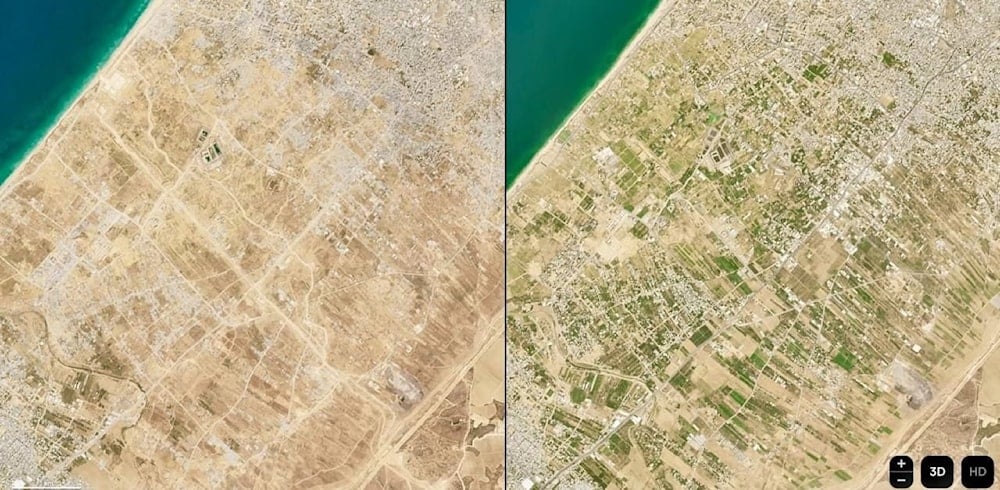Israeli forces building permanent infrastructure in Gaza: Haaretz
The IOF reportedly plans to hold onto four large areas within Gaza, reinforcing positions in locations like the Netzarim and Philadelphi corridors.
-

Satellite images show extensive destruction caused by Israeli forces in Gaza’s Netzarim corridor, which divides the strip into northern and southern sections. (@PalHighlight)
Haaretz on Wednesday reported that "Israel" is establishing extensive infrastructure in Gaza, suggesting intent for a prolonged occupation.
According to the report, what once appeared as temporary wartime setups—such as wide roads, water and power networks, and fortified military outposts—are increasingly resembling permanent installations.
Areas like the Netzarim corridor, where the Israeli Occupation Force (IOF) took control early in the war, are undergoing major transformations, with new roads and large staging grounds replacing residential zones.
-

Credit: Planet Labs PBC / September 26, 2024
This development is part of what the IOF describes as an effort to secure critical logistical paths and prevent threats from nearby structures.
Haaretz noted that the IOF's expansion efforts recall "Israel's" pre-2005 withdrawal from Gaza, when "Israel" maintained a permanent military and settler presence in the region.
Sources provided data showing the IOF's establishment of buffer zones and the clearance of northern Gaza, now largely devoid of civilians.
IOF sources indicate that around 20,000 civilians remain in northern Gaza, a fraction of the population that once lived there.
Read more: Ethnic cleansing plan underway in north Gaza, Israeli soldiers reveal\
The report further detailed the construction of fortified facilities for IOF troops, complete with amenities such as reinforced sleeping quarters, kitchens for kosher dining, and protected command rooms.
Troops stationed there reportedly described conditions resembling more of a permanent base than a temporary front, with one officer noting the presence of air conditioning, recreational areas, and other long-term amenities.
"We slept in reinforced containers with electrical outlets, air conditioning and everything, it was at a higher level than most of the outposts I was in during my service," an officer who served at the end of the summer at an outpost near the Netzarim corridor told Haaretz.
"We had a dairy kitchen and a meat kitchen [for the purpose of kashrut], a synagogue that was brought in, and the war room was also inside a protected container."
He said the feeling was that it was another front in the Gaza border area or in the West Bank, not a temporary arrangement in a danger zone.
"We went around without helmets and without ceramic vests, and played soccer inside the post," he added. "We grilled meat outside almost every night. There wasn't a sense of being in a war zone."
Satellite images show extensive destruction caused by Israeli forces in Gaza’s Netzarim corridor, which divides the strip into northern and southern sections.
— Palestine Highlights (@PalHighlight) November 13, 2024
Follow us on Telegram: https://t.co/fvRn3KuApw pic.twitter.com/An66br5VYw
Concerns of violations
The US has expressed concern over the attempt to starve civilians in Gaza, even as it continues to supply arms and weapons to the occupying forces.
Reports indicate that US officials have privately urged Israeli leaders to ensure the protection of Gaza's civilian population.
However, senior IOF officials acknowledged in closed discussions with Haaretz that efforts to move the population southward and raze structures near military installations are proceeding rapidly.
Read more: 'Israel's' carousel strategy in north Gaza aggravating suffering: NYT
The IOF reportedly plans to hold onto four large areas within Gaza, reinforcing positions in locations like the Netzarim and Philadelphi corridors.
One IOF officer remarked that the infrastructure being laid down makes it clear that these setups are not solely for short-term operations.
With road expansions, logistical corridors, and a buffer strip running along the separation line with Gaza, the IOF presence appears likely to extend well into 2026, despite public denials of any intent for a prolonged occupation.

 4 Min Read
4 Min Read








